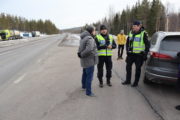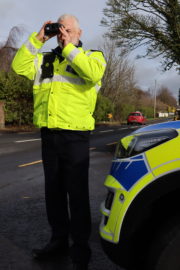Series 1, Episode 1
From road safety through to congestion, air and noise pollution, nothing gets Irish people more riled up than talking about our “bloody roads” and the people using them. With massive changes coming to how we travel in Ireland, Simon Delaney delves into the road safety and climate action issues we now face as he travels across Ireland and Europe looking at the changes happening to try to make our roads safer and greener.
Synopsis
How we travel in Ireland is going to fundamentally change over the next few years. Ireland’s new Road Safety Strategy aims to half road deaths and serious injuries by 2030 and bring that number down to zero by 2050 through measures that will, in turn, impact climate action issues such as congestion, emissions and noise pollution.
Over this four-part series, Simon Delaney looks at the big issues facing Ireland when it comes to road safety, shared mobility, and climate action. He finds out how we might make travel in Ireland safer, greener, and simply more pleasant, not just for the road users but also for the people living in the areas we move through.
To do this, Simon visits some of our European neighbours to look at what they are doing to reduce road collisions whilst keeping their traffic moving in a safer, greener, and more effective way. He then spends time with the teams tasked with keeping our roads and road users safe as well as the people behind the positive changes happening across Ireland.
He will be joined by Journalist Geraldine Herbert and Conor Pope to look at both the current state and the future of cars and our road networks as well why our capital city ranks among the most congested in Europe and the ongoing challenges of getting people out of cars and onto public transport, bikes, or walking.
Episode 1 – Monday June 6th
Simon joins the Nass Garda Roads Policing units where he sees a litany of road traffic offences and the challenges they face on a daily basis. He travels to urban and rural Sweden to see what we can learn from one of the world leaders in road safety and climate action. Conor Pope joins him to try and solve a problem called congestion and he takes a frank look at the issues we currently face and the big changes coming for urban Ireland within Ireland’s new Road Safety Strategy.
Content Strands
“Road Safety”
Whilst 2021 saw the lowest number of road deaths in Ireland since records began, the numbers so far for 2022, for both fatalities and serious injuries, are higher than where they were this time last year. To try and find out what are causing these collisions and what needs to change, Simon will visit the front line of road safety across both rural and urban Ireland to look at the challenges we currently face. Here, he joins the Irish Community Air Ambulance paramedics providing emergency service cover to the Southwest. He goes on patrol with An Garda Roads Policing Units in Kildare across both day and night shifts. He spends both morning and evening rush hour “working” on the M50 alongside the road maintenance and emergency recovery teams. He also joins Gardaí and RSA Vehicle inspectors on road checkpoints and goes on duty with some of Ireland’s School Safety Wardens.
“What are the neighbours doing?”
To get a clearer picture of the potential solutions to our road safety and climate action issues, Simon looks at challenges faced, and solutions posed by some of our European neighbours. He discovers that for most of these countries the issues of road safety and climate action are fundamentally linked.
He visits Stockholm, the capital of Sweden, one of the world leaders in both road safety and climate action, to find out what “Vision Zero”, the new strategy we have signed up to, actually means. Does the future for Ireland mean more than just investment in infrastructure? Do we need to fundamentally shift our thinking away from a “Not in my back yard” attitude to a more basic “do it for the great good” ethos?
He joins the Swedish Traffic Police in the northern region of Lulea (about 40km below the Artic Circle) to see what challenges they face when it comes to enforcement and prevention. Are they dealing with the same issues our Roads Policing units deal with here?
He journeys to Northern Spain (Bilbao and Barcelona) where a combination of a 30km speed limit on all urban and suburban roads and increasing the actual space given to active travel has made their urban roads and areas safer, greener and a lot nicer to live in.
In Barcelona, where massive air and noise pollution issues forced the city into drastic action, Simon visits the Super Blocks projects to witness neighbourhoods that are now virtually car free.
He travels to Brussels to look at the bigger picture of road safety and climate action within the EU and how the decisions and laws made in this city directly impact twenty-seven countries and almost four hundred and fifty million people. He also looks at the massive progress the city of Brussels has made in reducing car fatalities and serious injuries as well as reducing emissions and pollution by promoting active travel, reducing urban speed limits, and embracing a greater share of the road space across the different road users.
To look at the big changes coming for Ireland, we don’t need a crystal ball, we just need to visit our nearest neighbours – Wales. Here Simon looks at the massive changes currently happening, and those planned, for both rural and urban Wales when it comes to climate action and road safety. With Wales using active travel as one of the key solutions to their road safety and climate change challenges, Simon discovers that, these potential solutions are also being deemed a key tool in tackling Wale’s public health issues.
With 20M/PH soon to becoming the default speed limit in all urban and suburban areas of Wales, Simon visits a small town on the coast of Pembrokeshire to see how simply reducing the speed limit has dramatically changed the lives for the people living in that area.
“The national and local changes”
Across both urban and rural Ireland, change is happening. One million euro is currently being spent a day on better and safer infrastructure for cyclists and pedestrians. Remote working hubs are offering commuters an alternative to spending hours each day behind the wheel. Speed limits on urban and suburban roads are being reviewed for possible reduction. The greater use of technology to assist enforcement will help combat the big contributors to road collisions. The way our medical emergency services deal with collisions and trauma is going to fundamentally change, for the better. Improved public transport systems are being implemented across both rural and urban Ireland. The roads and streets we travel on and vehicles we use will also drastically change from both a road safety and an environmental point of view.
But, outside of the big national plans, local change is taking place right across Ireland. Here, Simon spends time with the community campaigners who are lobbying to get their local “accident black spot” fixed, the speed reduced on their rural commutes and the area around their kid’s schools made safer.
There is no “fix all” solution to solving Ireland’s massive travel issues. There is, however, a fairly radical plan coming down the line for both rural and urban Ireland, which will see a fundamental change to the way we use, police, and support all road users. Across this series, we will look at the current issues, the potential solutions, and the plans to make transport in Ireland safer, greener, and better for everyone.
Simon Delaney (Presenter) quotes.
“I spent two months travelling across both Ireland and Europe looking at the road safety and climate action challenges we face here in Ireland and what our European neighbours are doing to help fix their own issues.”
“Across the series, I take a long hard look at how we travel across Ireland, addressing the big issues we face daily, from collisions to congestion, and I look at the links between road safety and climate action”.
“Speed reduction, especially in our towns and city streets seems to be the key ingredient to help make them safer spaces. From Barcelona to Brussels, Bilbao to Stockholm, I visited the cities and towns already embracing a 30KM urban speed limit; and in each case, I saw streets that felt safer, quieter, and generally more pleasant to be on.“
“A major contributing factor to our air pollution is the emissions coming from our cars, vans, busses, and trucks. Across Europe, I talked to the people crediting speed reduction and increased use of public transport, walking, and cycling with massive improvements to the air quality of their town and cities.“
“Across Europe, I heard the same basic message, if we can make our roads safer, then more people will embrace the bike, walking and public transport, resulting in less private cars on our roads which in turn will mean less congestion, better air quality and less noise pollution.”
“Ireland’s new Road Safety Strategy will improve our active travel infrastructure and services, it will improve the resources needed for enforcement and will help make both our cars and our roads safer. But for things to really improve we firstly, need to get over the attitude of “not my back yard” that still seems to exist across much of Ireland.”
“Over forty thousand vehicles are involved in collisions across Ireland each year. To combat this, we have a new road safety strategy that aims to half road deaths and serious injuries by 2030 and eliminate both by 2050. It’s called Vision Zero and the changes we are making will also help us tackle climate action issues such as congestion, emissions, and noise pollution.“
“To try and find out why there are still so many collisions on our roads each year, I spent time with the Garda Roads Policing units, in Naas. Here, I saw a litany of road traffic offences from speeding and mobile phones right up to people driving under the influence of drugs; over three thousand of these ‘drug drivers’ were arrested across Ireland last year alone.“





